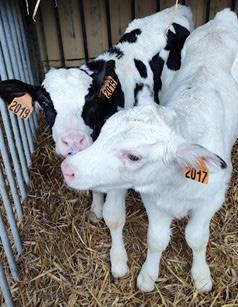
5 minute read
Feed Compounder - March/April
Supplementing Copper in Calves
By Vet Leandro Royo and Dr Rahma Balegi, Animine
There are multiple factors that can affect copper (Cu) metabolism in cattle, many of which remain poorly understood. These factors may be due to the animal’s own metabolism, nevertheless, copper metabolism can also be affected by external factors, such as the presence of antagonists and starch in the diet.
Introduction
Copper (Cu) is crucial for the proper functioning of adult cattle and calf organisms. It is primordial to maintain the immune system, growth and productivity of farm animals. Copper, like many microelements, is a constituent of several enzymes and proteins involved in many metabolic processes, including cellular respiration, anti-oxidant system, lipid metabolism, and reproduction etc. Copper deficiency during the intrauterine foetal development or in early growth may have adverse effects on animals’ health and performances in the future. Later, copper deficiency in ruminants is generally secondary and happens due to decreased copper bioavailability, in the presence of antagonists of this element in feed or forages, such as molybdenum (Mo), sulfur (S) and iron (Fe). In order to prevent this, there are tendencies to supplement Cu in injections at an early age or in milk replacers to meet or exceed the requirements. Indeed, copper toxicity in pre-ruminant calves occasionally is encountered as a result of excessive supplementation of replacers with the element, as we often forget that a young calf is physiologically monogastric.
Young Calves are not affected by the antagonistic events in the rumen
Even though the copper requirement is well known, Cu is the most common trace mineral (TM) deficiency in adult ruminants due to the interaction with some antagonists including S, Mo and Fe that influence its bioavailability. More precisely, S interferes with Cu via sulphides formed in the rumen; this compound has a strong affinity for Cu and forms insoluble Cu sulphide complexes (CuS). They are eliminated via the faecal route. Rumen sulphides and molybdates form together thiomolybdates. This complex has a high affinity for Cu, making it insoluble and therefore less bioavailable to the animal. There are 4 forms of thiomolybdate, described according to the number of S atoms. A Mo intake of 3-4 mg/kg dry matter (DM) is sufficient to reduce Cu uptake. In addition, Cu uptake is decreased when animals have a high Fe intake (Fe /Cu> 100; risk of Cu deficiency) due to ingestion of Fe-rich soil, drinking water or pasture rich in Fe.

Regarding copper supplementation in calves, great care must be taken, as these animals do not have a fully developed functional rumen. This means that calves don’t have the effect of antagonists (S and Mo) in the rumen, making Cu more available for absorption in the gut. A large fraction of the antagonist (especially Mo) comes from forages; a feedstuff that is present in small amounts in calf’s diets.
The absorption of Cu in the gut of calves seems to be more effective when compared with adult animals. As Cu is absorbed from the intestine, it enters the liver where Cu is either utilised in normal hepatocyte metabolism, stored bound to metallothionein (MT) or, if Cu balance is positive, excreted into the bile (Bremner, 1991). MT seems to play a main role in the Cu excretion into the bile.
Beware of copper toxicity due to milk replacers
In the field, both acute and chronic forms of Cu toxicity in calves have been observed. Important excess of Cu in milk replacer can cause acute toxicity leading to severe gastroenteritis and rapid death. However, the chronic form occurs when a lower excess of Cu is ingested over an extended period, resulting in an accumulation of Cu in the liver. In fact, in ruminants, Cu is extensively stored in the liver (with concentrations ranging from 100 to 450 mg Cu/kg DM) because of limited biliary Cu excretion. If there is a large influx of Cu into the liver, the capacity of the MT to bind Cu and the lysosomes to remove Cu from the cytosol can be exceeded, and Cu starts to accumulate at a higher rate in other organelles (mainly in the nucleus), or, at even higher Cu accumulations, may remain as free Cu ions in the cytosol; in both cases, Cu is responsible for severe changes in liver structure and function. When the liver Cu tolerance is exceeded, hemolytic crisis occurs resulting in anemia, jaundice, and frequently rapid death.
Copper levels in cow milk is only about 0.15 mg/l, whereas dairy calves are fed milk replacer that typically contains 10 mg/l of Cu. The present level allowed for pre-ruminant calves could jeopardise their health due to the high accumulation of copper in their liver. Consequently, the copper level authorised in feed should ideally be reduced to 5 mg/kg in milk replacer to protect calves’ health. This, in addition, would lead to a reduction in the human consumer exposure. Furthermore, the absorption is higher than 50% for the milk replacer in young calves and less than 5% in growing ruminants mainly fed with roughages. Copper supplementation of dairy calves also occurs when calves are fed calf starter or other grain mix rations that contain copper. Dairy calves typically begin consuming these calf starter rations in the first week of life. Once dairy calves are weaned, copper supplementation continues in the total mixed ration.
Conclusions
Do not forget that calves do not have a physiologically developed rumen. It is necessary to take into account all the sources of Cu that the calf is receiving, to avoid overdosing. Calves are very efficient in absorbing and storing Cu in the liver. Chronic copper intoxication can have later consequences on the productive and reproductive life of these animals.

